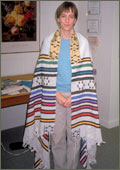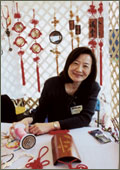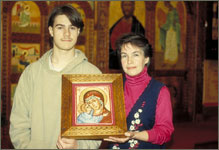Craft Traditions – Worship & Celebration
Worship is an activity that people can enter into with family, friends, and neighbors in quiet concentration. They can also worship in more social ways at religious celebrations, which are often joyful and full of activity.
For both types of religious experiences many cultures have developed craft traditions to help them bring more meaning to their worship and rituals. In some traditions, the level of craftsmanship is thought to reveal the sincerity of devotion. Thus, makers of religious crafts usually apply their best efforts toward making objects of great beauty and importance.
Many craft traditions for worship and celebration involve textiles. Cloth, thread, and fiber are often easier to obtain and work with in the home than metal or wood. A wide variety of patterns, textures, and designs are possible using a single technique or a combination of weaving, embroidery, or knot-tying.

In New Hampshire there are a number of artisans who maintain craft traditions that are built around practices of worship and celebration. Here are three:
Marjorie "Moocho" Solomon is a member of the Jewish community in Bethlehem, a town in northern New Hampshire with a large and historically important Jewish population. Moocho grew up in a weaving household and after her marriage became interested in weaving tallitot, which are shawls worn by men during prayer and special ceremonies. She began by doing research with older weavers and religious leaders and learned how to weave these special shawls.

Kung Tai Tsay
with some of her
knotted work.
Originally from Taiwan, Kung Tai Tsay is active in the Chinese Culture Society of Greater Nashua. She does chung kao jeh (Chinese knot-tying), which she learned from an older Chinese woman many years ago. The ornamental pieces are used for making some pieces that are practical and some that are devotional--from necklaces, bracelets, and buttons to Buddhist symbols.

Galina Tregubov with her son
and one of her embroidered
ecclesiastical icons.
Galena and Father Andrew Tregubov, immigrated to the United States from Russia in 1975. Both create orthodox icons-Galena embroiders them and Father Andrew paints them. The art of embroidered and painted ecclesiastical icons dates back to 10th-century Byzantine and Russian iconography. The icons are considered direct windows to the spiritual world.
Subjects include the Mother of God, the Annunciation, Christ the Savior, and the Holy Shroud. In old Russia, a woman who was able to make iconography or ecclesiastical embroideries such as banners, shrouds, curtains, and covers for the church was considered to have a very valuable gift and special virtue. The work of the Tregubov family is exceptional and sought out by Orthodox churches around the country who commission their work.
New Hampshire State Council on the Arts
19 Pillsbury Street - 1st Floor, Concord, NH 03301


